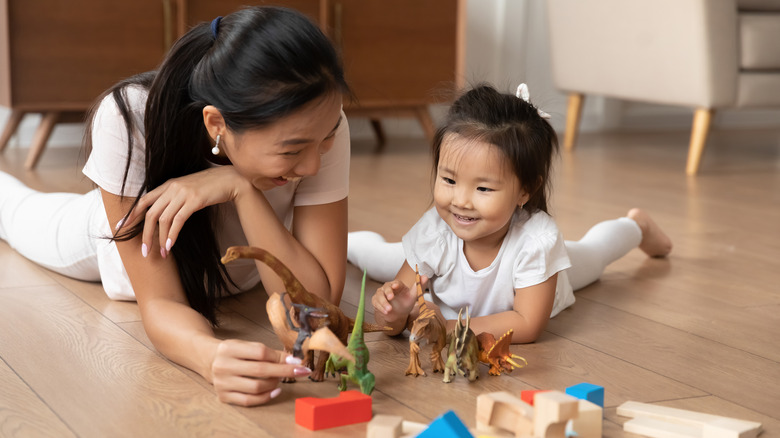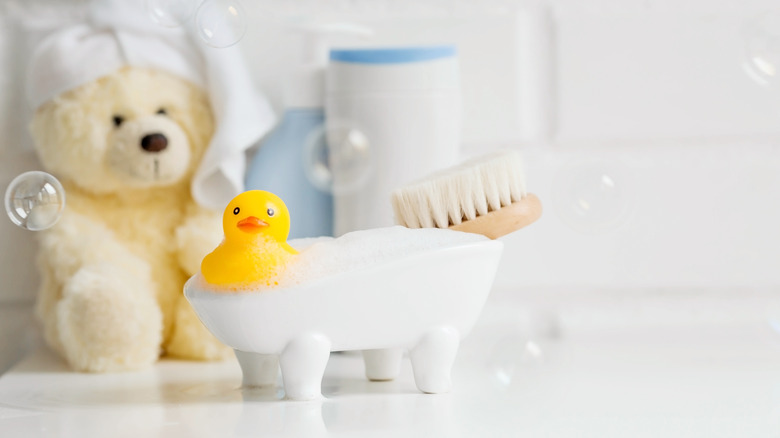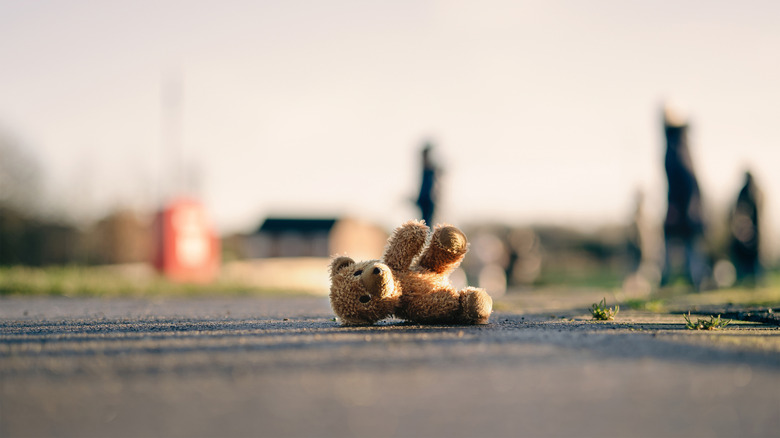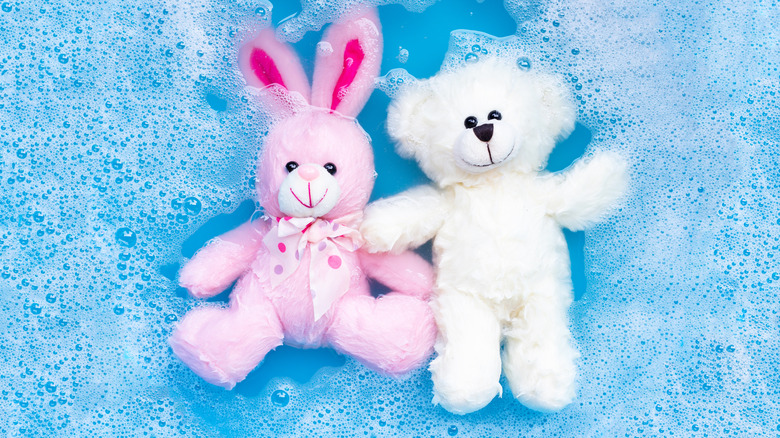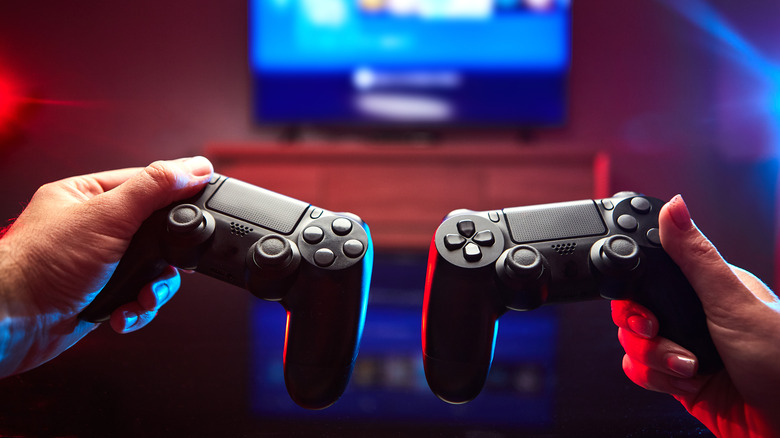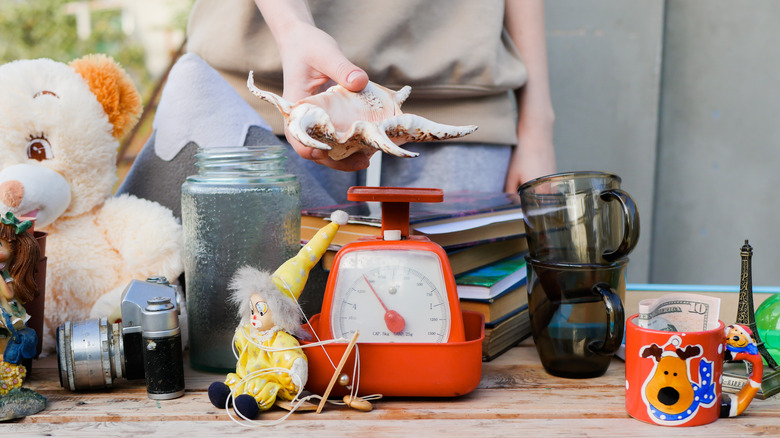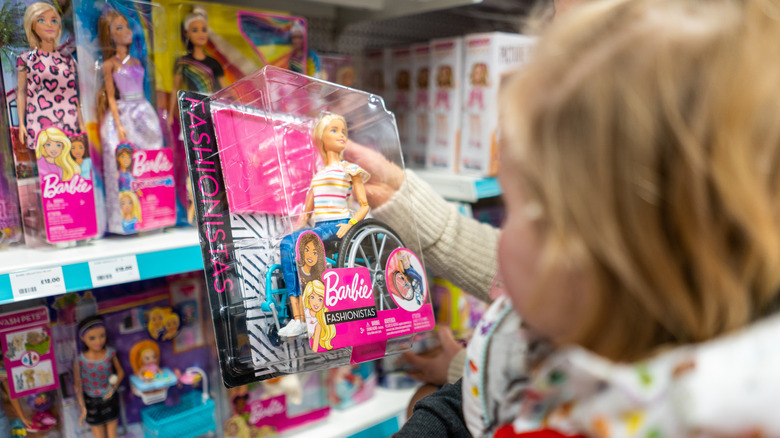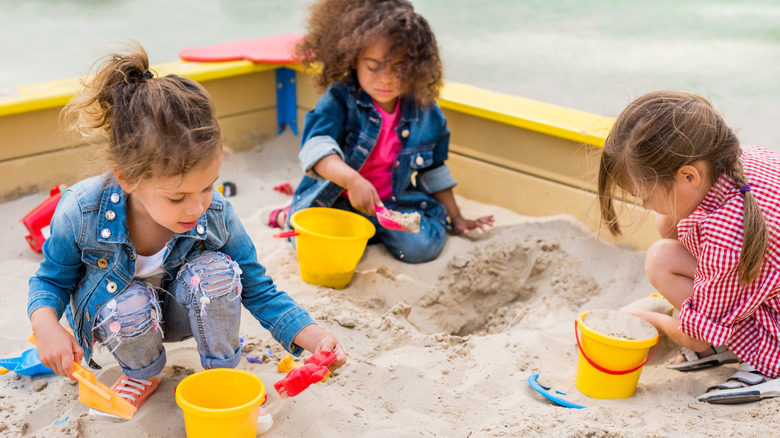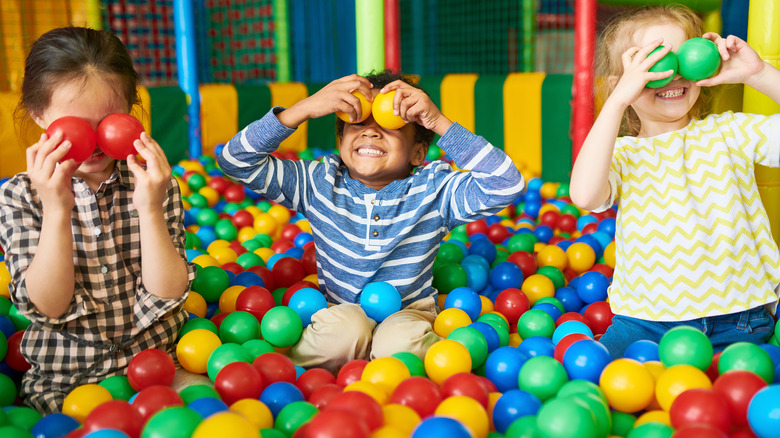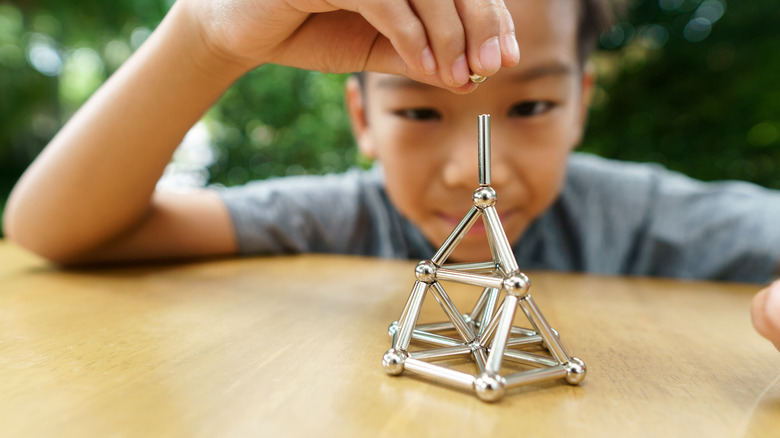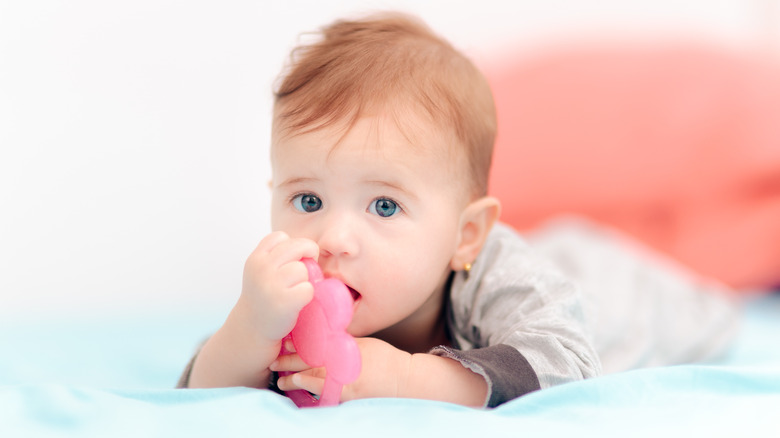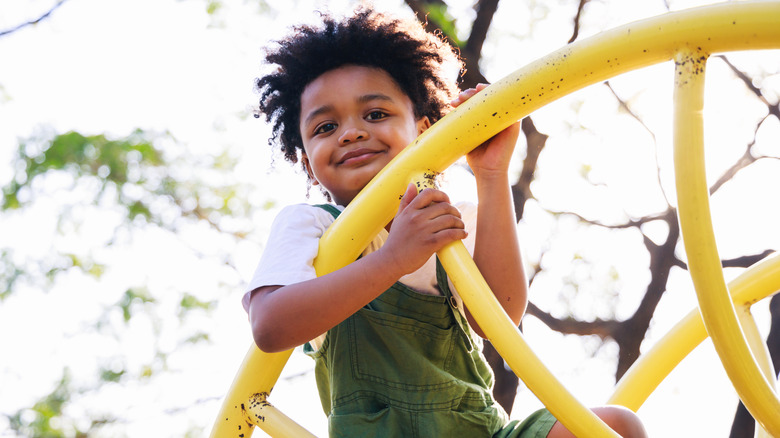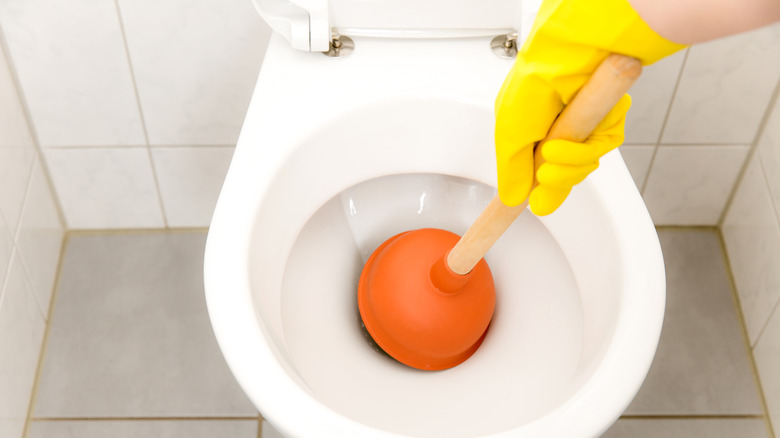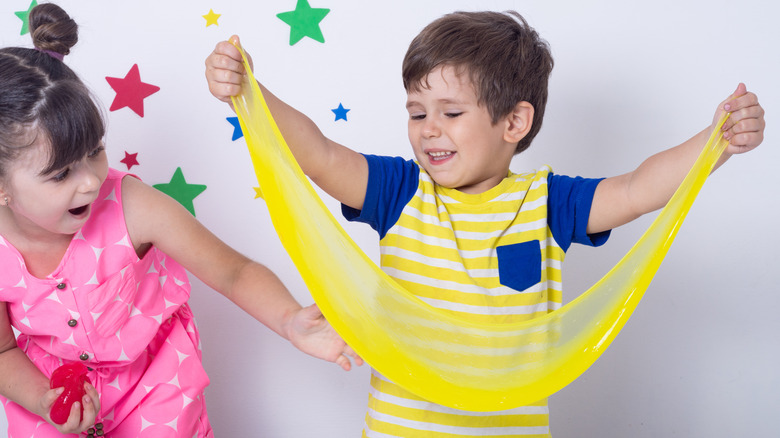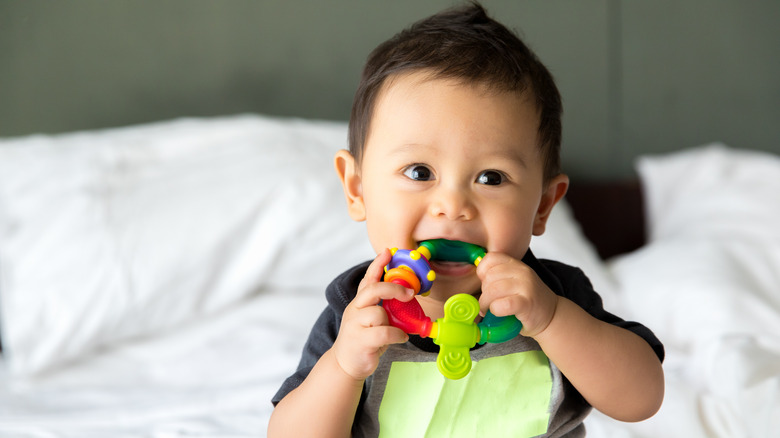Disgusting Facts About Your Kids' Toys That May Disturb You
There are few things that leave a more lasting impression on children than their favorite toys. For parents, however, these playthings typically become the object of a strong love-hate relationship. It's incredibly rewarding watching your child's eyes light up when they unwrap the perfect toy over the holidays or on their birthday. Additionally, the right toy can lead to countless hours of fun — for both children and parents alike. At the end of a long day, however, your children's various toys often come together to form one big mess, as noted by Motherly. If left somewhere unexpected in your house (like the hallway) they can also become a major hazard.
When lost in the never-ending cycle of playtime and clean up, we tend to think of kids' toys superficially. Spend a bit more time reflecting on what they do and where they've been, however, and it's enough to make you feel queasy. These playthings — large and small, at home or in the outside world — are breeding grounds for germs, and can often present unexpected risks to you and your children. Here are some surprising gross facts that you may not know about children's toys in and around your home, as well as tips to help take the ick factor out of playtime.
Favorite bath toys get moldy
Bath time can often be a challenge for parents with young children. The struggle to not only get the kids in the bathtub, but keep them there until the job is finished is all too real. How are you supposed to wash behind their ears when they're squirming to get out of the tub? That's why bath toys are such a blessing. When your children have dedicated playthings that they only get to interact with during bath time, it gives them something to focus on while you get the job done. Plus, the unique possibilities that come with aquatic playtime makes their evening bath something to look forward to.
Understandably, the rubber duck has become one of the most iconic toys around. The bright yellow color, familiar shape, and smiling face make children feel like they're being greeted by an old friend every time they get into the bath. Unfortunately, that cute exterior often hides something far more disgusting — and potentially dangerous. According to Childrens MD, when water gets into rubber bath toys through the small hole in the bottom, the hollow cavity inside can develop mold, fungus, and bacteria. The amount of mold present is unlikely to cause harm, but if dirty water from a toy is ingested by a child or gets in their eye, it can lead to infection — as one mother and son from Chicago learned firsthand, per GMA.
Some stuffed animals have never been washed
If baths happen in the evening in your household, the chances are that bedtime isn't far off. While every family follows their own routine, most young children have a beloved stuffed animal or blanket that they simply cannot sleep without. Seeing your kid snuggle up with their favorite teddy bear is guaranteed to melt your heart. But have you noticed that Mr. or Mrs. Teddy is starting to look a little bit shabby? When was the last time that your child's comfort object got a proper cleaning? If your child has developed an attachment to a blanket, you're likely washing it every week or so along with their sheets. But what about that teddy bear?
According to research by Dettol, a household cleaning supply brand, 90% of stuffed animals get dropped on the floor regularly, shares BanBridge Leader. Depending on how strong of an attachment your children have formed with their comfort object, that could be outside in the backyard, in the car, or even during an outing in a high-traffic public space like the grocery store or a subway station. And yet, it's reported that 20% of children's teddy bears have never been washed. Even after an illness, 75% of stuffed animals remain unwashed. That all adds up to a whole lot of bacteria that your child is carrying around with them — and snuggling up with.
Teddy bears can lead to food poisoning
As explained by the Daily Mail, the germs on teddy bears present a very real threat to children's health. It was found that 80% of children's comfort objects carry harmful bacteria that can result in food poisoning if ingested. Considering the fact that kids put just about everything in their mouths, this is a significant risk. Perhaps even more shocking, the same Dettol study found that a staggering 25% of stuffed animals tested positive for fecal matter.
Thankfully, the dangers of dirty teddy bears can easily be avoided with regular cleaning. The Spruce recommends washing stuffed animals at least once a month — ideally during nap time or when a child is away at daycare to minimize the risk of them being upset by its absence. If, however, the child has been ill or the stuffed animal has been involved in a particularly messy play session, it's never a bad idea to add an extra cleaning to the schedule. If the toy is old or fragile, consider hand-washing it with a bit of detergent in the sink. A gentle cycle in the washing machine should be safe for most teddy bears, especially if they're placed in a pillowcase or mesh bag to reduce potential wear and tear.
Video game controllers are absolutely filthy
It goes without saying that the average teenager's room is enough to make any parent feel a little nauseated. As they mature and their interests evolve, however, you'd expect their toys to be less of a cause for concern — but you'd be wrong! Video game controllers are downright filthy. Research conducted by Betway Insider compared the level of bacteria on controllers for the leading gaming consoles, including the Nintendo Switch, PS5, and Xbox Series X/S. On average, gaming controllers were found to have three times the bacteria found on a toilet seat. Mold, Bacillus spp, and staphylococcus were the most prominent types found.
Cleanliness is all well and good, but no one wants to spend $80 on a new gaming controller to replace the one they fried while trying to sanitize it. To that end, follow the guidelines outlined by Mel Magazine to clean video game controllers safely. Of course, the best approach is to change gaming habits in the household. Anyone using the console — kids and adults alike — should always wash their hands before and after playing. The same goes after a bathroom break. If you clean your controllers regularly, sanitizing them can be as easy as a quick wipe down with isopropyl alcohol and a microfiber cloth. For controllers that have been neglected, you'll want to do a deep clean with q-tips, toothpicks, and a toothbrush to cut through the grime.
Lead is illegal but remains common
As reported by Green America, demand for eco-friendly green toys is on the rise. Parents are more conscious than ever about the many scary, disgusting, and potentially harmful chemicals and toxins being used by toy manufacturers around the world. Among the biggest red flags to look out for when it comes to children's toys is lead paint. Ingesting lead has been linked to nerve and brain damage. Research has also pointed to developmental and learning difficulties, reproductive problems, and even certain types of cancer.
As recently as 2007, NBC News estimated that 35% of new toys contained lead. Many of them were found to be above the U.S. limit for children's toys, which was 0.06% or 600 parts per million at the time of the study. Since then, the Consumer Product and Safety Commission has significantly reduced the limit to 100 parts per million. While the standards have become more strict, the frequency of product recalls is a reminder that many questionable toys still make it into stores before being flagged as dangerous. This issue is further complicated by the way toys circulate. Hand-me-downs and garage sales mean that we don't always know where a toy came from. As a general rule, it's recommended that parents check regularly to stay informed about recalls, both new and old.
Barbie's unhealthy figure is deadly — literally
There are a lot of dangerous germs and chemicals hiding in kid's toys. Sometimes, however, it's the message that a toy carries that's the most disgusting. For example, Barbie is the world's most popular fashion doll. According to Fox Business, 58 million Barbie dolls are sold each and every year. As revealed by the American Addiction Centers National Rehabs Directory, this iconic doll has long set a dangerous standard for beauty — one that is not just unrealistic but downright impossible. The company has since expanded its line to include a wider range of body types. For years, however, Barbie was 5'9" and 110 pounds, which meant that this role model was a shocking 35 lbs underweight.
Taking a closer look at Barbie's physique, the report highlighted a number of debilitating health issues in the doll. Barbie's neck would leave her incapable of lifting her own head, while her tiny feet would make it necessary for her to walk on all fours. Her thin waistline of 16 inches (relative to her scale) means that her abdomen could not contain the necessary organs. Comparing Barbie to real-world women, many of her measurements only come close to reality in the case of severe anorexia. This is the sort of subtle but disturbing influence that parents will want to be extremely careful about when choosing what toys to bring into their home.
Parasites in the sandbox
Trends in kids' toys come and go, but few childhood experiences are more timeless than playing in the sand. A sandbox is an opportunity for children to let their imaginations run wild and get their hands dirty; a bit of dirt and grime under the fingernails is all part of the fun. A parasite in their digestive system? Not so much. Leave a young kid playing with anything long enough, and it's only a matter of time until they put said object in their mouth. When it happens to be sand, that choice comes with a whole lot of baggage, question marks, and risks.
A 2015 Slate article explains that sandboxes are actually 2,000 times dirtier than the doorknobs of public bathrooms. And while sandboxes are a fun play space for young kids, cats see them as nothing more than giant litter boxes. If the sandbox in question happens to be frequented by any stray cats, there's a risk that your child could be exposed to a parasite passed on from cat feces. As such, every sandbox should be evaluated on a case-by-case basis. If old enough, kids should be taught to keep their hands out of their mouths while playing. If you've got a sandbox in the backyard at home, consider buying a cover to keep local animals out of it.
There are more than just balls in ball pits
Unfortunately, as anyone with a kid in daycare can tell you, children don't really need outside help to spread illness amongst themselves. A ball pit, be it at a dedicated indoor playground or kids' area of a fast-food restaurant, is typically a small area that can be tough to navigate. Add to that literally hundreds of individual plastic balls, and it becomes very difficult for even the most diligent of businesses to properly sanitize this unique play area. Ball pits present such a distinctive challenge, in fact, that in 2020, McDonald's CEO Chris Kempczinski told Time that ball pits could be phased out for good.
So, exactly what sort of nasty stuff is crawling around in ball pits, just waiting to latch onto your kids and hitch a ride back to your house? Honestly, too many different germs to name them all. A study published in the American Journal of Infection Control took samples from ball pits and found 31 different types of bacteria, as well as a strain of yeast. According to WebMD, the offending germs carry risks for everything from urinary tract infections and conjunctivitis to more severe concerns such as heart inflammation and blood infections. All things considered, it might be simpler to find other ways to keep the kids busy.
Magnetic toys are more than choking hazards
Parents are always looking for exciting new toys to keep their kids not only entertained but stimulated too. To that end, magnetic building kits are a great way for children to get creative while simultaneously learning new skills. Unfortunately, those small pieces can be easily swallowed if the child in question is too young or isn't being properly supervised. The idea of any toy making its way through your child's digestive system likely makes you more than a little queasy. You're always going to worry about discomfort and the risk of complications. At the very least, it means you'll be checking their stool for a few days to make sure that they've passed the offending object.
When the toy in question is magnetized, however, the risks are far higher than usual. According to Healthychildren.org, if the child swallows more than one of the high-powered magnets typically used in these kits, the magnets can pull towards one another internally, causing trauma to the digestive system. Such situations pose life-threatening risks to the child. Should a child ever swallow one or more magnets, you should seek immediate medical attention. For this reason, it's crucial to follow age restrictions and only allow children access to magnets when closely supervised.
A controversial chemical for teething children
It can be gross to think about, but you likely have some potentially dangerous chemicals in your home that you're totally unaware of. Namely, phthalates are a family of chemicals used to soften plastic and make it more malleable (via Baby Center). While some chemicals bond to plastic when applied in the manufacturing process, phthalates continue to leach out of the material, which is why soft plastics will harden with time. Though popular dating back to the mid-20th century across a wide range of consumer goods, phthalates pose a unique threat to kids because of a child's tendency to put toys in their mouth, increasing the likelihood of absorption.
The exact effect of phthalates on developing children is debated, and research is ongoing. To date, however, it's been posited that they could have a number of health concerns, including fertility, development in utero, asthma, hormonal development, delayed puberty, neurological issues, childhood obesity, and certain types of cancer. Thankfully, consumer protection agencies around the world are becoming increasingly strict about the use of phthalates — especially in children's toys. As reported by CNN, 2017 legislation added an additional five phthalates to the list of chemicals banned from use in the production of kids' toys.
Playgrounds are dirtier than toilet seats
Sandboxes seem to attract all manner of harmful bacteria and parasites, but sadly, the rest of the playground isn't much better. According to Clark.com, the most popular surfaces and objects at public playgrounds are, on average, 52,000 times dirtier than the personal toilet seat in a family's home. If you're looking to get specific, playground items like the seesaw, slide, and baby swings can have up to 9 million colony-forming units per square inch of their surface. While you'd think that outdoor spaces would benefit from the fresh air and the elements, park playgrounds were found to have significantly higher levels of bacteria than indoor play structures.
With many parents feeling more concerned than ever about the safety of their children from bacteria and viruses, Safe September has put forth a number of recommendations to help reduce the risk. Chief among them is the importance of hand washing, both for parents and children alike. Also, the play structures might be the most highly-touched surfaces, but benches and tables are hosts to similar germs. Regular hand sanitizing during playtime can also help, and teaching kids not to touch their face during playtime is also beneficial, if possible.
Children love toys that mimic bodily functions
What is it with kids and potty humor? Not long after a child develops language skills, they seem to become fixated with all the parts of the body and bodily waste that polite company would rather not discuss. This is nothing new, but 2018 proved something of a landmark year when numerous media outlets like Vox noticed that the biggest toy trend of the year was gross games and disgusting toys. First highlighted by eBay, the trend saw a rise in popularity of games that had kids playing with fake dog poop, pimples, and unicorn poop slime. Other bestsellers included a Play-Doh poop set and two games that involved a toy plunger and being the first player to get the plastic poop.
Reporter Jenny Marder explores this fascination in an article in The New York Times. According to Marder, who cites a number of experts, the fixation with potty talk comes from a child's desire to test their power, explore language, and alleviate anxiety about something that's become a big deal in their life: going to the bathroom. Talking about bodily functions gets a reaction from adults, so kids become fixated on this taboo subject. There's also a lot of pressure to perform as they learn to use the bathroom themselves, and so it also presents an opportunity to lighten the tension they might feel around going to the bathroom. So, does anyone want to play Flushin' Frenzy?
Toy Slime is icky and potentially dangerous
Whether it's designed to look like bodily fluid or not, toy slime is consistently gross stuff. It comes in all colors and consistencies, and each variety has its own distinctly icky appeal that kids just can't seem to get enough of. While parents might be turned off by it for obvious reasons, there are also more serious reasons to think twice about buying slime for your kids. As Healthline reports, a consumer advocacy group has raised some red flags about the chemical makeup of certain types of toy slime that may be hazardous to a child's health.
After testing dozens of slime products, the United States Public Interest Research Group discovered that six of them contained high levels of boron, a chemical commonly used in fertilizers. The amount used significantly exceeds European Union standards for boron in children's products, but because the U.S. does not yet have a limit on the use of this chemical in toys, there's no issue with selling stateside. Boron, however, is a known irritant and can cause severe gastrointestinal distress. As such, parents should do their research before buying slime for their kids.
Kids likely put toys (and everything else) in their mouths for the germs
Try as you might to teach them not to, your kids are going to put toys in their mouths. This is true of the toys at home, but also the toys they play with at daycare, school, a friend's house, and beyond. As it turns out, there's more to this compulsion than simple curiosity or a disregard for cleanliness. According to Fatherly, young children may actually be biologically driven to put foreign objects in their mouths. Exposure to different types of bacteria is exactly what they're after — they just don't know it.
Coins are famously filthy, and they account for over 60% of accidents involving a child swallowing potentially dangerous objects. It doesn't end with coins though. Kids also have the revolting tendency to sample organic substances like dirt or even their own bodily byproducts, such as boogers (dried nasal mucus). WebMD points to research that suggests that children need to be exposed to germs in order to develop a strong immune system. This may even have an impact on conditions like asthma and allergies. So while it might be completely disgusting for kids to put their toys in their mouth, it would seem that a little bacteria can actually do the body some good.
